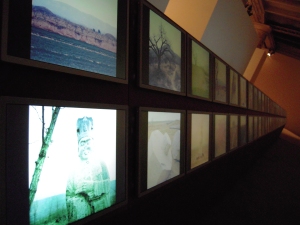The problem one faces when visiting any museum, let alone one that covers a whole city, let alone one that focusses on ‘all worldly knowledge’, is the sheer amount of impressions one has to deal with. Often you end up perusing through the lot of it, glancing over the area in front of you and tracing superficially what is presented. Of course you can also specifically look for certain works that you choose, but somehow it is also very tempting to try and get a glimpse of this ‘all worldly knowledge’.
And when you walk through it, head full of images and thoughts, emotions and boredom running through your veins, it could just happen that you stumble upon something that keeps your intention for half an hour or more, and which you know will stay with you for a while longer. Sometimes this does not happen. And sometimes it happens more than once in one day. If you’re lucky. (Or not, for who would want to be influenced by a work of art these days?)
There were several installations that were of particular interest to me. I will focus on one of them here, namely the installation by Kan Xuan, China. It was part of the Arsenale presentation and not part of any national pavilion. Instead, the curator choose this particular artwork ‘Millet Mounds’ (2012).

In it, Xuan showed hundred of nicely built frames beside each other in two rows, in which photos were shown as if in stop-motion, each sequence of maybe even a hundred photos having its own atmosphere and its own environment. On the wall next to it, a map was drawn for each frame, showing the trajectory of the artist while taking the pictures. Each frame, together with its map, could thus be seen as a memory of space and time. Each combining the two, in a very subjective manner. It looked as it each frame with the hundred or more photographs had their own filter, their own colour, their own emotion attached. But each frame, was arranged within an enourmous line of frames, showing the linearity of memory storage.
One of the things I ask myself when presented with a work of art that attracts my eyes, which keep me wondering and looking until my head because swallowed up by the vastness of it, is precisely why this work appeals to me. And when the answer to this question comes too easily, I am somehow put of by it, and forget about the work of art as soon as I can.
This obviously did not happen to me this time. At first I was fascinated by the colours and the rapid movement of the images. Focussing on one frame, what could I distill? Was there a story enfolded in front of my eyes? What did the artist want me to see? Why were these barren landscapes, that somehow all resembled each other in some way, enough to let me think they were taken at least in the same country, so interesting? I still don’t know.
The second wonderment that I felt, was when I tried to follow Elie During’s experiment. He had shown us in his seminar at the European Graduate School just a few days before, that it is possible to listen or to see different sounds or images at the same time. That is, not merely hearing or seeing the harmony between different tonal lines or visual images, but seeing two separate things, simultaneously.
This is what I tried with this artwork, and which lend itself extremely well for it. Not only was the whole artwork based on the idea of positioning oneself in space and time, as the maps on the wall indicated. Also the sheer amount of frames and space-time sequence of moments made this an extremely bewildering experience. I found it was possible to see about four separate instances of spacetime simultaneously. The result of this was not one field of vision, one experience of time, but a fourfold of space and time.
In the end, the impression that stays with me when I visit any museum is what attracted me in this artwork. And instead of it being a negative emotion, the overload of spacetime, images as well as experiences of time, made this such a beautiful experience. I could easily imagine myself being one of these frames, documenting all the images I had seen and would see that day visiting the Venice Biennale 2013. Besides me, the people visiting the same space, strangers and friends alike, all occupy their own frame. But when these frames could be put together somehow, without judgement or destinction, we would end up with what the biennale really consists of: subjectified spacetimes.
When you would want to present ‘all worldly knowledge’, this would be the only way to do so; By showing simultaneous spacetimes of all possible perspectives.